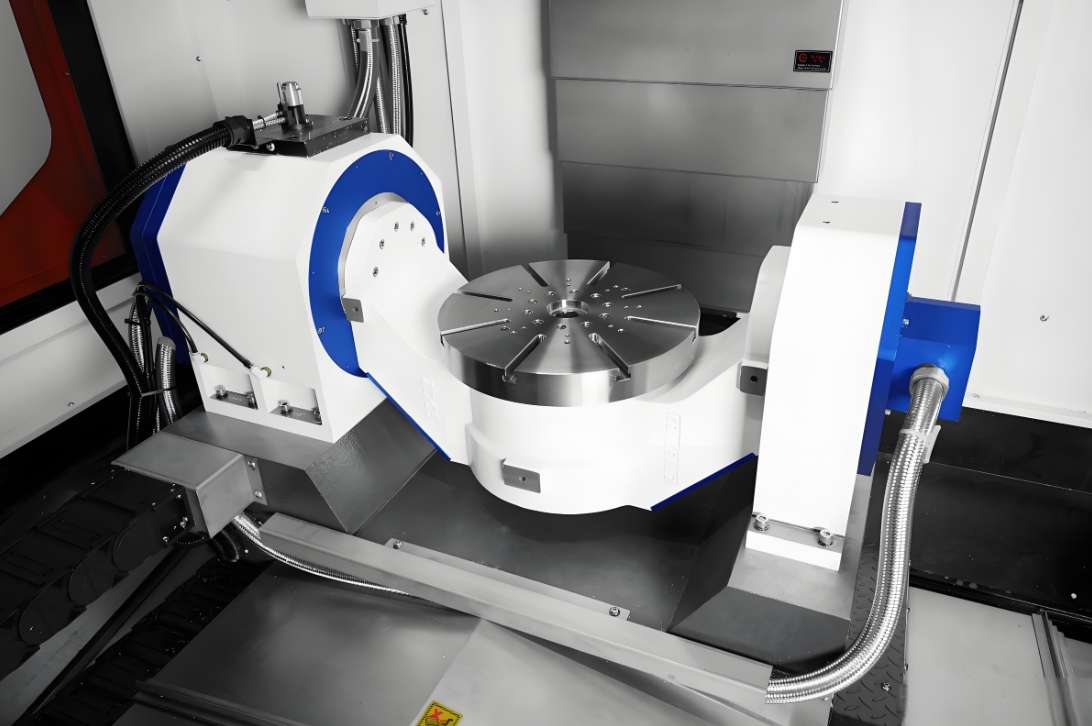Five-Axis Machining:Breaking the Bottleneck in the Manufacturing of Complex Aerospace Components
In the aerospace industry,the geometric complexity of components often seems daunting.The intricate surfaces of turbine blades,precise spatial angles on large structural parts,and thin-walled,deep cavities in lightweight designs—traditional manufacturing methods are often at a loss,becoming a bottleneck in project advancement.
The emergence of five-axis CNC machining technology is precisely the key to breaking this bottleneck.
Unlike traditional three-axis CNC machines,five-axis machine tools can move not only along the three linear axes(X,Y,Z)but also synchronize motion on two additional rotary axes,either on the worktable or the spindle head.This means that the cutting tool can approach the workpiece surface from almost any angle to perform milling and turning operations on precision metal parts.Imagine a master sculptor who can not only move the chisel up,down,left,and right but also freely adjust the angle of the material and the tool—five-axis CNC machining takes this flexibility to the extreme.
This has brought revolutionary changes to the manufacturing of complex aerospace components:
- Single-Clamping Formation of Complex Shapes:For parts with continuous complex surfaces or those requiring multi-sided machining(such as integral bladed disks in aero-engines and titanium alloy frames),five-axis machining allows the completion of most,if not all,processes in a single clamping.This eliminates cumulative errors caused by multiple clamping operations,significantly improving the final quality and precision consistency of precision metal parts,which is especially critical for aerospace components with extremely stringent tolerance requirements.
- Efficient Machining of Large and Irregular Parts:When machining large metal parts,traditional methods often suffer from low efficiency due to the cumbersome nature and difficulty in flipping the parts.Five-axis machining optimizes the tool's position relative to the workpiece by rotating the worktable or spindle head.For example,when machining large aircraft wing ribs or fuselage structures,the machine tool can automatically adjust the angle to keep the cutting tool in the optimal cutting position.This not only shortens machining time but also reduces the reliance on large specialized fixtures,enhancing the flexibility of large metal part machining.
- Enhanced Tool Efficiency and Surface Quality:Five-axis machining enables the"sweet spot"of the tool's side edge or ball nose to continuously participate in cutting,avoiding the inefficient state of tip cutting.At the same time,by precisely controlling the contact angle between the tool and the workpiece,a more stable and favorable cutting force can be maintained,reducing vibration and thus achieving better surface finish quality.This also significantly extends the service life of expensive cutting tools,which is of great significance when machining difficult-to-cut aerospace materials such as high-temperature alloys and titanium alloys.
- Solving Thin-Walled/Deep-Cavity Part Challenges:Aerospace components generally pursue lightweight design,with a large number of thin-walled structures and deep cavities.Five-axis machining allows the use of shorter tools or optimized tool extension lengths and provides better support rigidity by adjusting the tool angle,effectively suppressing vibration and deformation during machining.This ensures the structural integrity and dimensional stability of precision metal parts.
- Optimizing Process Flow and Reducing Overall Risk:Completing complex machining in a single clamping not only saves time but,more importantly,eliminates the risk of errors caused by multiple clamping and part transfer between different machines.Simplifying the process means higher reliability and more controllable delivery schedules.Moreover,improved machining accuracy directly reduces the need for subsequent manual finishing,rework,or even scrap,ensuring the final delivery quality of the parts.

These advantages ultimately converge into significant overall value:
Shortened Delivery Cycles:Fewer clamping operations and more efficient material removal accelerate production.
Cost Reduction:Reduced fixture investment,extended tool life,lower scrap rates,and simplified manual intervention.
Enhanced Part Performance:Superior geometric precision and surface quality directly relate to the reliability and service life of parts in extreme operating conditions.
Simplified Logistics:More centralized machining reduces in-factory part transfer and improves the efficiency of large metal part processing.High-precision machining also reduces the likelihood of rework,ensuring the quality and reliability of metal parts before transportation.
Five-axis CNC machining is no longer just a"tool"for solving complex geometries;it has become an indispensable core capability in high-end aerospace manufacturing.It breaks not only physical shape limitations but also the ceilings of efficiency,precision,and reliability.When faced with the next highly challenging aerospace part blueprint,advanced five-axis machining technology provides the powerful support needed to transform complex designs into high-quality realities.

